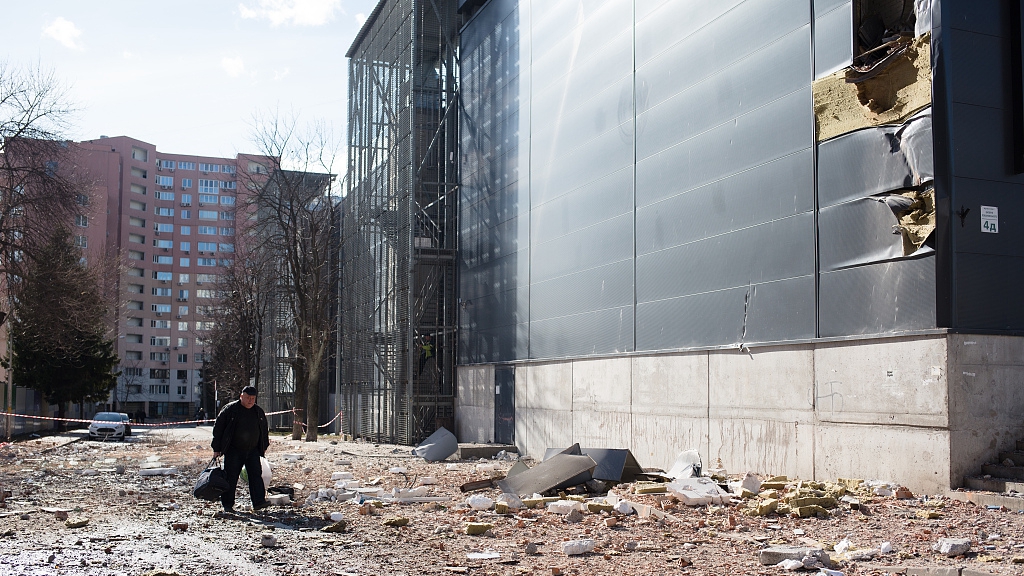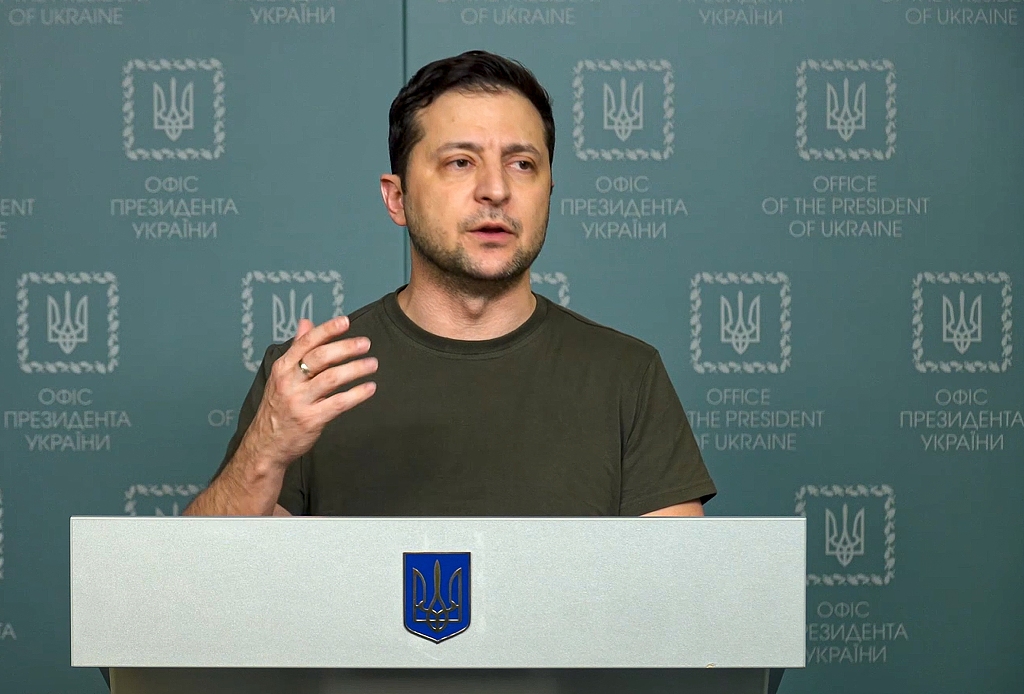
The apartment block in 6A Lobanovsky Avenue which was hit with a missile in Kyiv, Ukraine, February 26, 2022. /CFP
The apartment block in 6A Lobanovsky Avenue which was hit with a missile in Kyiv, Ukraine, February 26, 2022. /CFP
Editor's note: He Weiwen is a senior fellow at Center for China and Globalization. The views expressed in the article are the author's personal views and do not represent those of CGTN.
All eyes are on the Russia-Ukraine military conflict, which has become the top news around the world these days. Leaders of the U.S., NATO and EU states have all condemned Russia and announced a set of most severe sanctions.
China has made clear its stand for upholding the UN Charter, respecting sovereignty and territorial integrity, taking into full account the historical complexities, and seeking a peaceful solution through negotiations.
Then how can one find a fair and feasible solution to this problem?
After the collapse of the Soviet Union, Russia and Ukraine lived peacefully for over 20 years. But the U.S.-backed color revolution in early February 2014 changed the political environment and geopolitical interests in Ukraine. The Ukrainian government has since followed a clear-cut policy to line up with the West, seeking to join EU and NATO, which was written into the Constitution in 2019.
On the other side of the scenario is the constant eastward expansion of NATO since 1991, a strategy put forward by the U.S., against its promise of "not expanding an inch eastward."
On July 8, 1997, NATO summit decided to accept Poland, Hungary and Czech membership. Estonia, Latvia, Lituania, Slovak, Slovenia, Romania and Bulgaria became the NATO members on November 22, 2002, followed by Croatia and Albania's membership of NATO on April 3, 2008.
The U.S. has been the prime engine of NATO's eastward expansion. Its strategic goal is to enhance its leading role in Europe and contain Russia from rising up again.
A close look at the map of Europe presents a clear picture that Russia has been almost totally blocked on its western border except Belarus and Ukraine. So if Ukraine joins NATO, there will be no buffer zone between NATO and Russia, which is a direct national security concern for the latter.
NATO, an aggressive not defensive organization, is a super military alliance with massive arsenals directed at Russia. For example, it launched its barbarous bombing on Yugoslavia, including Chinese Embassy in Belgrade, and finally dismembered the country. Apparently, Ukraine's potential NATO membership crosses the red line of Russia's strategic security.
Over the recent years, and especially over the past two months, Russia had very intensive talks on its security concerns, demanding NATO's rejection of Ukraine, but was rejected bluntly by the U.S. and NATO.
Ukraine President Volodymyr Zelenskyy made no conciliation with Putin and insisted joining NATO and attacked the local forces in Luhansk and Donetsk, counting on all the mighty strength of the U.S. and NATO. Under these circumstances, Putin ordered the "special military operation" and hence the outbreak of Russian-Ukraine military conflict.

Ukrainian President Volodymyr Zelenskyy speaks to the nation in Kyiv, Ukraine, February 27, 2022. /CFP
Ukrainian President Volodymyr Zelenskyy speaks to the nation in Kyiv, Ukraine, February 27, 2022. /CFP
But after the beginning of Russia's "special military operation," Ukrainian people suffered tremendously. Some of the Ukrainians had to find shelter in the subway to avoid air raids, and at least 120,000 more fled to Poland and Moldova.
Over the past eight years, Ukraine's economy went from bad to worse and it became the poorest countries in Europe, with per capita GDP at only $3,724.9 in 2020.
But as U.S. President Joe Biden has had talks with Putin in recent months, it is hard to imagine that Biden didn't know what Russia's red lines are vis-a-vis Ukraine. It's more of a fact that the U.S. intended to witness a Russian attack so it can get an excuse to impose sanctions and augment its leadership position in NATO and Europe. The scenario also helped in suspending the Nord Stream 2 project, forcing Europe to buy American natural gas. What is more, a turbulent Europe means profitable arms business for the American military-industrial complex.
It's worth mentioning that Europe will not be a winner because European security, energy supply and trade, which can only be secured by stable Europe-Russia ties, will be severely influenced. The role of EU will also be overshadowed by a U.S.-dominated NATO.
The root cause of the situation is the wrong strategic positioning of Ukraine in European geopolitics. Former U.S. Secretary of State Henry Kissinger once pointed out that Ukraine should be a bridge linking the West and East, rather than a chess by the West to contain the East. It still holds true today.
Therefore, an ideal solution for the current crises would be for the Ukraine to maintain a neutral status by not joining any military alliance, which would help develop good relations with the U.S. and Europe while maintaining friendly relations with Russia. In this situation, Ukraine could keep a peaceful and constructive environment and further develop its economy, Russia can feel safe on its western border, and Europe-Russia trade and energy cooperation can grow in peace, thereby leading to a balanced and sustainable security landscape for Europe.
(If you want to contribute and have specific expertise, please contact us at opinions@cgtn.com.)

